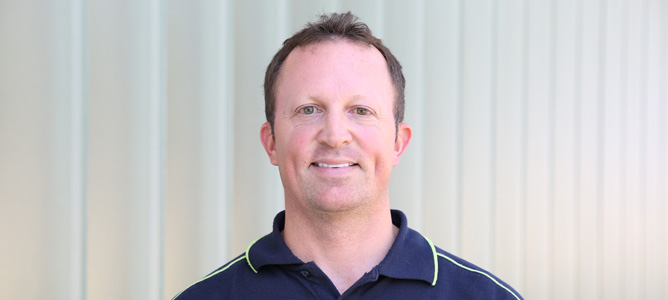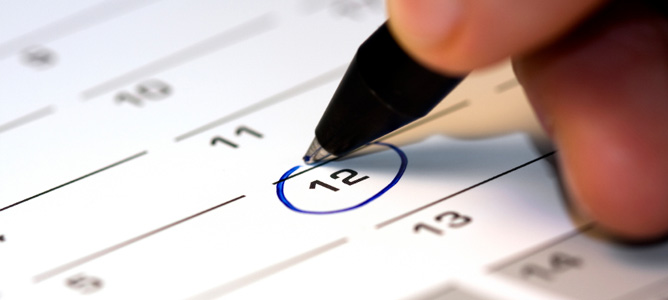Research into zinc oxide nanoparticles allays sunscreen concerns
In a paper published in ACS Nano in November 2013, researchers from MCN, The Australian Synchrotron, CSIRO, RMIT and Monash University showcased ground-breaking characterisation techniques which were used to enable research into the human immune response to zinc oxide nanoparticles.
Zinc oxide nanoparticles are used in many consumer products such as sunscreen since they are largely insoluble in water and invisible to the eye, unlike larger white zinc particles which remain white on the skin. However, the behaviour of zinc oxide nanoparticles in biological systems is not well understood. This led the team of researchers to delve into what happens to these nanoparticles after they are absorbed into our skin.
The research team used x-ray fluorescence to image immune cells which had been treated with zinc oxide nanoparticles. Using the world-class Maia x-ray fluorescence detector at the Australian Synchrotron, the researchers were able to count how many of these tiny particles had been absorbed into the cells.
In order to observe the nanoparticles once in the immune cells, the researchers used the Focused Ion Beam Scanning Electron Microscope installed at MCN to mill away very thin layers of the cell (100x thinner than a human hair), re-imaging the cell as they went. Combining these different techniques produced a unique collection of high-resolution images that allowed the team to observe the immune cells breaking down the nanoparticles as they moved deeper into the cell.
''This is the first time that we have shown that the cells of the immune system can break down the nanoparticles directly,'' said Australian Synchrotron and CSIRO bioinorganic chemist Simon James. ''Previous work was only able to infer that.''
The images showed that on average, 60,000 nanoparticles made it into a single white blood cell. ''60,000 nanoparticles is a tiny, tiny amount of zinc,” Dr James said, “especially seeing as the cells are able to break the nanoparticles down."
What’s more, 50 to 60 per cent of the zinc oxide nanoparticles were entirely broken down by the macrophages within just 24 hours of entering the cells, with the remaining 40 per cent in the process of decomposition. Dr James explained that in the study, the nanoparticles did not reach the cell nucleus, demonstrating that human macrophages function as expected, ingesting and breaking down any zinc oxide nanoparticles before they can enter the blood stream.
“In response to some concerns, this research shows us conclusively that the nanoparticles in sunscreen are unlikely to cause harm to beach-goers," said Prof Ian Olver from Cancer Council Australia, “unlike the sun’s damaging UV rays which we know lead to higher rates of skin cancer and skin damage.”
The unique imaging techniques used in this study have demonstrated that correlative photon and ion beam imaging can provide both high-resolution and statistically powerful information on the biology of metal oxide nanoparticles at the single-cell level. This approach promises ready application to broader studies of phenomena at the interface of nanotechnology and biology.
FIB-SEM microgripper success
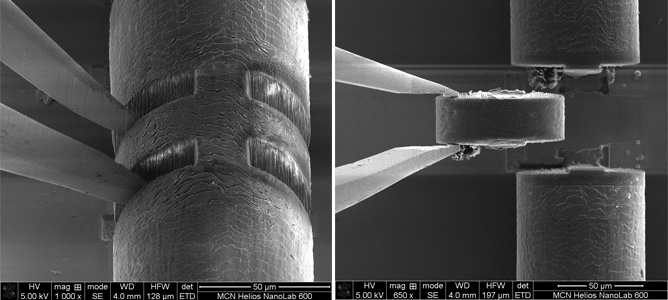
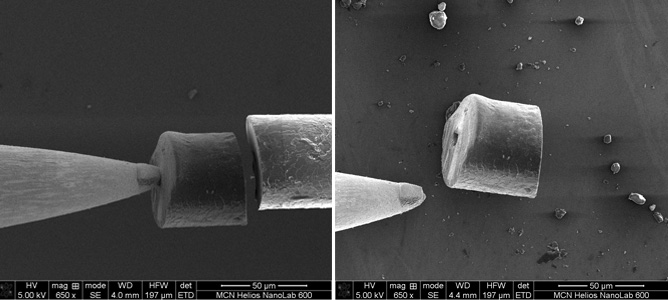
The recent installment of the Kleindiek Lift-Out Shuttle on the MCN Dual Beam Focused Ion Beam Scanning Electron Microscope (FIB-SEM) has helped VahidReza Adineh, a Monash University PhD student, to achieve what was not possible with several months of work using the standard 3‐axis micromanipulator.
VahidReza was aiming to take a thin slice of a mouse whisker and place it cut-side down on a silicon wafer so that he could then utilise the Atomic Force Microscope to perform characterisation on the sample. However, with the regular micromanipulator probe installed in the FIB-SEM, it was almost impossible to place the whisker segment cut-side down on the wafer. After several months of trying different section lengths, placing methods and needle placement, VahidReza had not been able to successfully gain the sample needed for imaging.
With the installment of the Kleindiek Nanotechnik Lift-Out Shuttle, the sample was able to be prepared within just a few hours. The microgripper was used to gently grip the sample while it was removed from the whisker, after which it controlled the placement of the whisker segment on the wafer and secured it with the deposition of platinum patches.
The Lift-Out Shuttle allows users heightened control of their samples in situ and is consistently reliable and efficient in manipulating very small objects, saving users time and money. For more information on how you can make the most of this capability, please contact Fatima Eftekahri.
2014 seminar series
The MCN’s new seminar series launched last week with a successful Technology Fellow Showcase! The half day workshop highlighted some of the most exciting projects taking place at MCN in fields such as photonics, plasmonics, optics, microfluidics, biosensors, predictive modelling and surface acoustic wave atomization. Among the presentations, Assoc. Prof. Wenlong Cheng from Monash University highlighted the progress being made in wearable, flexible electronic sensors, Dr. Yonggang Zhu from CSIRO discussed microfluidic chips for chemical and biological synthesis and Dr. Brian Abbey from La Trobe University presented on the characterisation of materials through x-ray and neutron technologies to produce data that feeds into predictive models. These presentations and more will be available to view on the website over the coming weeks. Subscribe to the MCN Youtube Channel, Nanofabtv, to receive notifications when the videos are live.
Another three fantastic seminars will be held over the coming months on a range of topics, all with inspiring speakers who are leading the charge in their field. The seminars are free of charge and open to everyone, however registration is required to assist with catering.
On Thursday 8 May, the MCN Diamond Deposition Suite will officially be launched, following a public seminar on the exciting applications for diamond. Newly commissioned in 2014, the Diamond Suite extends MCN’s capabilities into the growth of both ultra high purity diamond and boron-doped diamond. The panel of experts, including Prof. Steven Prawer, Prof. Lloyd Hollenberg and Dr. Alastair Stacey, will share the growing opportunities for diamond in fields such as medical bionics, biosensors, electronics, quantum information processing and manufacturing applications.
On Thursday 29 May, MCN presents a SEMIP seminar where five of the facility’s most accomplished industry clients will share with you the work they have developed at the MCN and discuss the various processes they undertook and challenges they overcame during this engagement. Included in these speakers are Managing Director of Eden BDM, Alexander King; Vice President of Research and Development at Vaxxas, Angus Forster; Chairman and Director of Seagull Technologies, Harry Unger; Director of Research and Development at Innovia Security, Gary Power; and Managing Director and founder of start-up company Micro-X, Peter Rowland.
On Thursday 26 June, the MCN’s brightest PhD students will take to the stage to present their PhD topic in just two minutes. Challenging them to deliver an engaging presentation which highlights the importance of their research, the PhD frenzy gives students the opportunity to engage audiences and hone their communication skills, while also giving them the chance to win exciting prizes.
Event times, location and registration information can be found at the events page of this website. Don’t miss out on the opportunity to be a part of these inspiring events and register your place today.
New tabletop SEM installed

To assist cleanroom users with faster Scanning Electron Microscope (SEM) characterisation, a tabletop SEM has recently been installed within the Class 10,000 cleanroom space. The Hitachi TM3030 SEM with Oxford EDX is capable of performing high-resolution characterization without sample preparation and provides flexibility and convenience without sacrificing resolution or quality.
The tabletop SEM can hold a 70mm sample and can achieve up to 30,000x magnification. The Oxford EDX allows Linescan, Mapping and Multiple Point Analysis as well as Light Element Detection from Boron upwards.
The Tabletop SEM is just another way the MCN is aiming to streamline user workflows and minimize instrument wait time. If you are interested in more information on the new SEM, please contact mcn-enquiries@nanomelbourne.com.
Visiting plasmonics experts
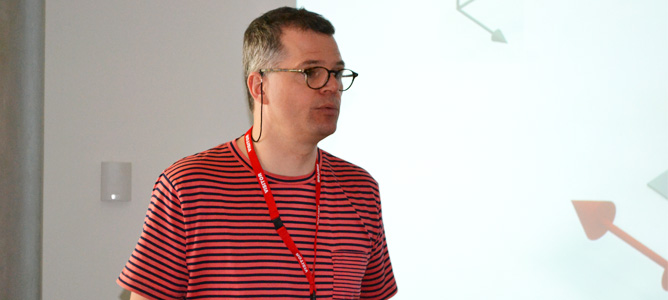
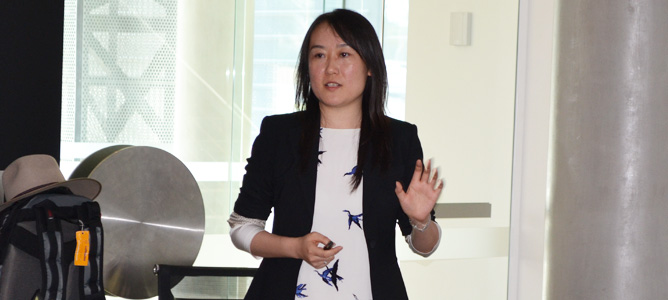
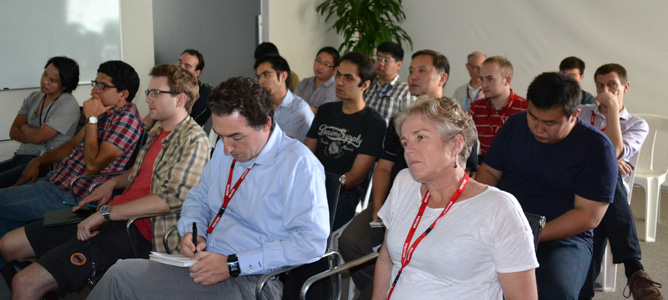
Visiting world experts in plasmonics, Professor Harold Giessen and Dr Laura Na Liu recently enlightened audiences at MCN.
Chair of Ultrafast Nanooptics in the Department of Physics at the University of Stuttgart, Prof. Harald Giessen discussed complex plasmonics, taking a look at the fundamentals before discussing their possible applications. Plasmonics is the technology based on electrical resonances excited by light on metal nano particles that enables the properties of light to be manipulated at the nano scale.
Prof. Giessen touched on chirality with a plasmonic model system, before discussing non-reciprocal plasmonics for controlling the polarization of light, known as the Faraday Rotation. He finished by presenting a number of novel sensing applications, ranging from 3D rulers for measuring displacements of molecules to novel plasmonic gas and liquid sensors.
A group leader at Max Planck Institute for Intelligent Systems and recipient of the prestigious Sofja Kovalevskaja Award, Dr. Laura Na Liu shared her work on three dimensional DNA plasmonics. She discussed the control of complex arrangements of 3D plasmonic structures using DNA self-assembly or DNA origami. Due to the intrinsic programmability and excellent functionalities of DNA, the plasmonic nanomachine can respond to external stimulus upon recognition of biochemical events or stimulated movements of the DNA template. These 'smart' plasmonic nanostructures can be used as sensors for biological systems to help answer questions of structural biology.
The talks by Prof. Giessen and Dr. Liu were organized by MCN Technology Fellows, Tim Davis and Daniel Gomez from CSIRO.
Image of the year winner announced
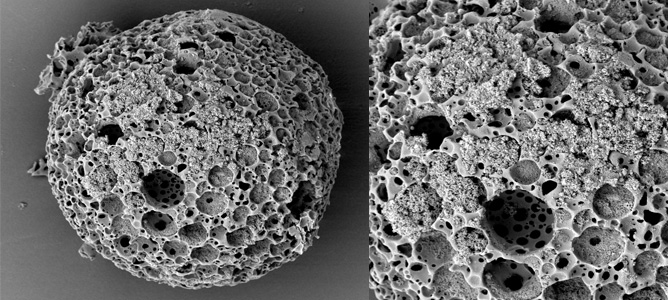
The MCN wishes to congratulate Dr. Florian Lapierre for his winning image in last year’s Image of the Year Competition, PolyHIPE. Reminiscent of a lunar landscape, Florian’s image shows a highly porous polymer bead, which was generated using an easy-to-manufacture microfluidic device and cross-linked under UV irradiation.
This PolyHIPE material with 80% porosity shows potential for use in a range of applications including tissue engineering, 3D cell culturing, bio-catalysis and hydrogen storage.
Dr Florian Lapierre is a Postdoctoral Fellow at CSIRO Materials Science and Engineering under the supervision of Drs Yonggang Zhu, Thomas Peat and John Oakeshott. The work was completed in collaboration with Prof. Neil Cameron from Durham University, UK.
A big thank you to all participants for their many wonderful entries.
MCN at ICONN 2014
The start of February saw MCN and ANFF attend the International Conference on Nanoscience and Nanotechology (ICONN). Held concurrently with the 23rd Australian Conference on Microscopy and Microanalysis, the conference attracted a large number of delegates interested in microbiology and nanocharacterization.
The ANFF booth was alive with discussion and activity with lunchtime demonstrations in microfluidics, 3D printing and a versatile enhanced surface plasmon resonance sensor based on optical fibres. MCN Process Engineer, Lachlan Hyde ran an A-maze-ing race competition which saw competitors race an oversize maze puzzle to take first place on the leaderboard. Congratulations to Nima Dehdashti, Nicholas Tse and Melanie Ramiasa – the three lucky winners who took away a bottle of award winning South Australian wine for their speedy times, and thank you to everyone who stopped by the booth!
New faces at MCN – Bernie Orelup
MCN would like to welcome Bernie Orelup, who recently joined the team as a Senior Process Engineer. Bernie brings with him a multidisciplinary background in materials science and engineering (BSc - Purdue University), business administration (MBA - Arizona State University), and management.
Prior to joining the MCN, Bernie spent 17 years with the semiconductor fabrication industry, working in process engineering and manufacturing with Intel Corporation. His expertise includes nanotechnology process development, process characterisation, equipment start-ups, manufacturing operations, cost reduction, quality control, and employee management and training. Bernie also brings a wealth of industrial cleanroom fabrication experience and knowledge in the areas of dry/chemical etching, thin films deposition, and optical photolithography to support MCN clients.
Virtual tour of MCN cleanroom
If you’ve ever been curious about what the inside of the MCN's world-class cleanroom looks like, or if you’ve wanted to share the experience with your friends and colleagues, you can now do so with a virtual tour in the video below.
Subscribe to our Youtube Channel, Nanofabtv, to be the first to see our videos as they go live!
Upcoming events and dates
As well as MCN’s seminars which are running in the first half of 2014, MCN will also be attending National Manufacturing Week (13-16 May) and the World Congress on Biosensors (27- 30 May). Drop past the MCN booth to find out how you can get involved and for the chance to win prizes in the upcoming competitions.
Find out more about MCN's upcoming events at the events page of this website.



